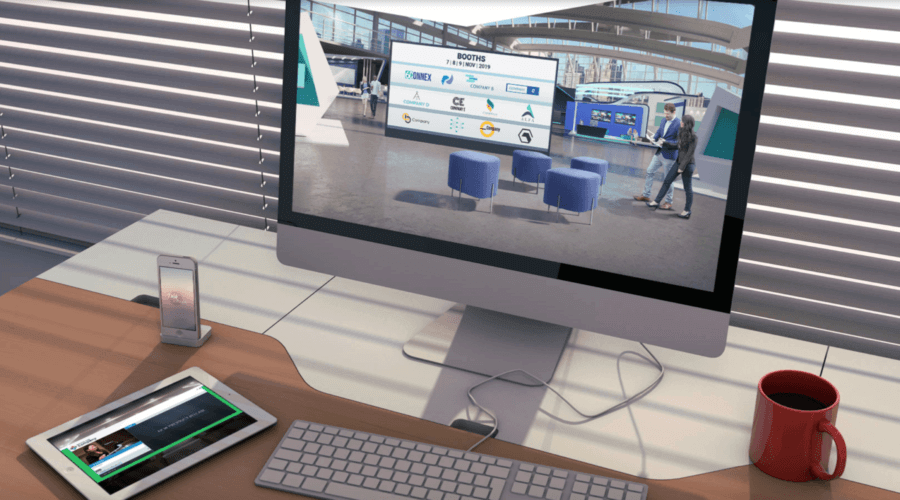Retreats have long been a welcomed, refreshing respite from the rigors of day-to-day work. They’re a chance for like-minded people to come together in a more casual environment, learn new things, and have some fun along the way. Companies and groups used to host these events at urban hotels, coastal cities, mountaintop venues, and plush rural farms. But in an age of lessening travel and crowds, how do you plan a retreat? You take it online!
If a virtual retreat sounds boring to you, we get it. But we assure you it’s anything but! We sat down with Angela Proffitt, an event and productivity consultant and founder of GSD Creative, for an expert look into how to plan the perfect retreat from start to finish and keep your “guests” engaged and enthused throughout the day. She’s been crafting virtual conferences, workshops and meetings for well over five years, and has been in event planning for more than 20. These tips can translate to any and every group — from an extended family reunion to a book club summit. If you think it might be time to reinvigorate and realign a group you’re a part of, here’s your guide.
RELATED: Your New Guide To Virtual Meeting Etiquette
STEP 1: CONSIDER HIRING A PLANNER
“The first step is to hire a planner,” Angela says immediately through a laugh. We know that some smaller groups won’t have a budget for this, and there are plenty of tools you can use to plan your event (this article being one of them!) if a planner doesn’t make sense. “A lot of people don’t know what things cost, so that’s where a planner comes in handy,” Angela says. “Planners take care of guiding and educating you along the way. We will set up the platforms to use, design a timeline for you, manage the guest list, swag, presentations, videos … we organize it all!”

STEP 2: THE WHEN AND THE WHO
First things first: Set a date and your guest list. You want to tell your group as far in advance as possible (six weeks minimum lead time!) to give people ample time to clear schedules. Somehow even our WFH (a cool acronym for work from home) schedules are jam-packed these days. Is this retreat open to more people than just your employees or core group? Figure out your attendance goals (examples: 100% of employees, 100 people or 1,000 people) ahead of time. This is important for the platform you choose, too.
Once the guest list is set, start collecting everyone’s info in a Google doc or sheet. Backing up this information to the cloud is important because it’s collaborative, editable, and a great way for people to see who’s registered or change their information on the fly. “Even if it’s a free retreat, you want people to register and put it on their calendar,” Angela says. Making the retreat feel on-brand, official and cohesive is more likely to build excitement and engagement.
STEP 3: CREATE A BUDGET
Set a budget for your retreat and consider your costs. This is one of the biggest benefits of hiring a planner, but a planner does add to your budget. Research the costs associated with necessary video production, music licensing, and, most importantly, the platform you will be using for the retreat. Other things to ask when creating a budget: Do you want to hire a speaker? Are you going to mail anything out to attendees? Will you hire a designer to create a logo, slide presentations or other marketing materials? Do you want to hire a tech person for the event? Again, the budget will correlate with the number of attendees.
As far as the platform goes, Angela suggests looking into 6Connex, Intrado, and Zoom Rooms. Each of these has customizable pieces to enhance the user experience and make guests feel like they are actually at a retreat and not just in a typical meeting. Her current favorite is 6Connex, which also integrates with Zoom, so you can use Zoom for the video and 6Connex for the virtual experience. These companies can do everything, but depending on how much budget you allocate to those platforms, it’s going to matter which third party you involve. There are also local companies like Orange Threads Live in Nashville, TN, (where SB is headquartered) that will integrate top-notch production into your event safely with your organizers on-screen. Think 3D backgrounds, green screens, holograms, and professional lighting and sound. “The platform and the experience for your guests is the MOST important investment for all of this,” Angela reminds us. Think of it as your venue.

STEP 4: SPREAD THE WORD
It’s time to market this puppy! Give your retreat a name that speaks to the theme or the topics of the day. If you want to get really fancy, create a URL and a website for the retreat. This could also be a tab on your company page. Depending on your goals for programming, you might want to create a theme and even an event logo that you could use for merch, swag and marketing — “even if you are just marketing the event internally to your group,” Angela says.
If it’s a family reunion or something more casual, using a private Facebook group or event is a great place to put all the information and give real-time updates to notify attendees. On your website (and social media where applicable), post new event features as they’re confirmed (i.e. announce the keynote speakers, an exciting new sponsor or a huge giveaway) as you start to build out the schedule and add elements to the day. This is a great way to have all the information in one place.
STEP 5: CONSTANTLY COMMUNICATE WITH GUESTS
If you are sending things to your guests — whether it’s reading material or swag or cocktail kits for the end of the day — make sure you know what’s going out to each, the shipping cost, and who’s assembling it. “We start sending out swag about a month in advance,” notes Angela. “And we start to send emails out to guests about a week out. The goal here is to totally pump your guests [up]. Like an artist about to release a new song. You want to get people excited.” Send out videos from the CEO or event organizers, and announce different exciting parts of the programming bit by bit. “You still really want that human touch, and video really does that for you right now when we can’t be together,” Angela notes.

STEP 6: MAKE SURE THE DAY-OF RUNS SMOOTHLY
Anyone with a speaking part should have a script written out and the day’s run-through schedule. Organizers should get together with the speakers and host or MC to run through the day, test out presentations and screen shares, pinpoint voice levels, test run music, and try out auxiliary programming you plan to use (giveaways, trivia, etc).
For bigger events, have a number and an email address that is dedicated to customer service and tech questions. This is important for both before and during the event. “Ninety-five percent of issues people will have will come from user error,” Angela says. Have at least one person in charge of tech support to troubleshoot for any not-so-tech-savvy attendees. Tell all guests to test their internet speed, camera and mic before the event.
RELATED: 8 Expert Tips to Look Amazing on Virtual Meetings
STEP 7: KEEP ENERGY LEVELS HIGH ALL DAY
“Music, music, music, music!” Angela says. Make sure you have the licensing for your music and that you purchase it if you plan to record the retreat and post it to YouTube or any public digital space. Soundsnap is a great resource for high-energy tunes that don’t have many lyrics so that you can speak over them if need be.
“Hire an MC or host who does not have a monotone voice!” Angela suggests. They can welcome everyone, invite them into different virtual breakout rooms, introduce the speakers, keep the time, coordinate the Q&As, and pump the group up for giveaways. Some local DJ and band leaders are very good at this.
Having a timer on the screen is simple but important. It lets people know when the next break is and holds your speakers accountable. “Setting expectations with an agenda upfront is extremely important, and staying on time is very important — otherwise you’re going to start to lose people.”
Angela also suggests you change things up every 30 minutes. Whether that’s a new virtual background, or a new speaker, or a new activity, keep it rolling and keep it fresh. Have a fitness person come in and get everyone off their feet to move, stretch, dance and laugh for a bit.
Ask people to participate. On-screen polls, competitions and giveaways are a great incentive for engagement, and you can set rules like “must be present to win” or “take the post-event survey for a chance to win!” Try to give away things that people can actually use (electronics, subscriptions, etc. — this definitely depends on the type of crowd), and they’ll likely be engaged. Some platforms have a feature where you can hide clues within the retreat like a scavenger hunt.
STEP 8: IT’S NOT OVER WHEN IT’S OVER!
“The most important thing is post-event!” Angela says. “So many people think ‘Ahhh the event’s over! We’re done,’ but really, that’s when it starts.” Surveying, targeting, and following up with your guests and keeping them engaged is so important. Set the expectation upfront about the user experience so that people want to come back next quarter or next year. “So many people forget to do this. But really that’s when it starts!” says Angela. Record your screen and then splice up the video to send out to people if they want.
PRO TIPS: THINGS THAT WORK
“The platform you’re using, again, is just so important,” says Angela. You can customize and design what looks like an actual lobby of a retreat or convention, and from there, you can click around to go to different workshops or find different resources. “You want to wow people!”
Live Q&As with the group’s leader, CEO or the event organizer is a great way to recap the day and allow guests to ask any burning questions that may have popped up throughout the day.
Breakout rooms for live networking and small groups are also a great tool. Zoom has a breakout room feature that will automatically and randomly separate group attendees into smaller groups. Make sure you have a moderator to keep the time and take people back to the main room.
One great touch that Angela did for a client was to send each attendee a homemade margarita kit that they all could make collectively at the end of the day. “Sending out activities in the mail before the retreat has worked really well,” she says. At the end of the day, encourage a little time at the end (built-in — don’t make people stay past the end time!) where everyone can pour a drink of choice and cheers to a successful day!
We wish you all the most exciting and successful of virtual retreats, whether you’re planning or attending. And thank you to Angela Proffitt for sharing your expertise and tips. Learn more about services she and her team offer at angelaproffitt.com.
**********
Give your inbox the Southern makeover it deserves! Subscribe to our daily emails HERE!



















